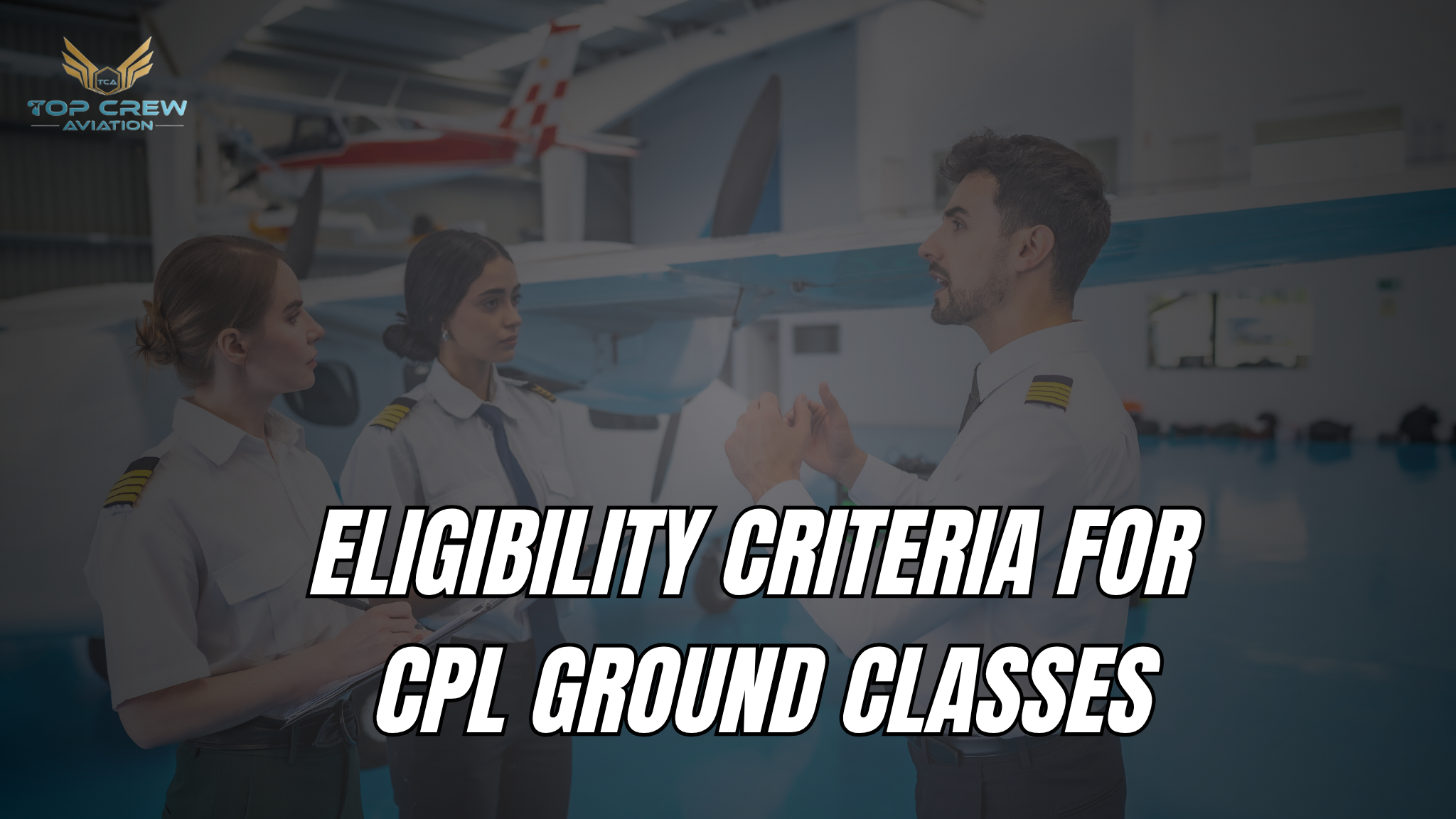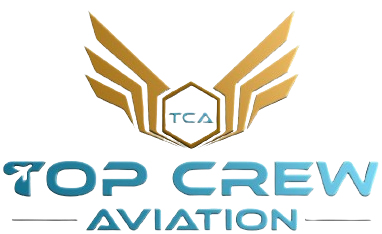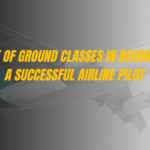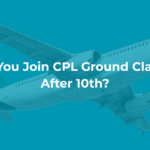
Have you ever dreamed of flying high above the clouds, commanding an aircraft, and turning your love for aviation into a career? Becoming a commercial pilot is one of the most rewarding journeys anyone can take. But before you can soar in the skies, there’s an important first step: CPL Ground Classes.
For many aspiring pilots, the term “CPL” (Commercial Pilot License) sounds exciting but also overwhelming. That’s natural—after all, this license is your ticket to becoming a professional pilot. But before you can begin training in the cockpit, you need to understand the eligibility criteria for CPL ground classes. These are the minimum requirements that make sure you’re ready—mentally, physically, and academically—to start your aviation journey.
Think of ground school as the foundation of your flying career. It’s where you learn navigation, meteorology, aviation regulations, and the science behind flying. Without these basics, getting into the cockpit is like driving a car without knowing the rules of the road.
In this blog, we’ll break down the eligibility requirements for CPL ground classes in simple, clear language. We’ll cover age, education, medical requirements, documents, and more. Whether you’re a school student dreaming about aviation or a graduate planning a career shift, this guide will help you understand exactly what you need to start your journey.
By the end, you’ll have a step-by-step roadmap to prepare for ground classes confidently. So, fasten your seatbelt—your pilot career starts here!
Minimum Age Requirement
One of the first things you need to check before enrolling in CPL ground classes is your age eligibility. Aviation authorities have set minimum and maximum age limits to ensure candidates are ready for the responsibility of flying.
Age Criteria for CPL Ground Classes:
- Minimum Age: 17 years (to enroll for ground classes)
- Minimum Age to Apply for CPL License: 18 years
- No Official Maximum Age Limit – but practical career opportunities may reduce after 35–40 years.
Why Age Matters:
- At 17, most students have completed school education, which is the base requirement.
- Mental maturity and discipline are essential for handling aviation knowledge.
- Airlines prefer younger candidates for long-term careers.
Example Scenario:
- Ravi, 17 years old: He can enroll in CPL ground classes now, complete his theory training, and by the time he turns 18, he can move to flying training.
- Neha, 25 years old: She can still apply for CPL ground classes and later become a professional pilot. Many pilots even start in their late 20s or 30s.
Quick Tip:
If you’re still in school but passionate about aviation, you can start preparing early. Focus on subjects like Math and Physics, as they are crucial for ground classes.
You must be at least 17 years old to begin CPL ground classes. The earlier you start, the better your chances of a longer career in aviation.
Educational Qualifications
Next up on the eligibility checklist is education. Flying may seem all about controls and instruments, but the science behind it relies on a strong academic base.
Minimum Education Requirement:
- 10+2 or Equivalent with Physics and Mathematics
- From a recognized board (CBSE, ICSE, State Boards, IB, IGCSE, etc.)
- English proficiency is highly recommended, as aviation communication is in English.
What If You Didn’t Study Math/Physics in 12th?
Don’t worry—you still have options:
- Clear Physics/Math through National Institute of Open Schooling (NIOS).
- Appear for equivalent exams approved by DGCA (Directorate General of Civil Aviation).
Why Physics & Math Matter:
- Physics explains aerodynamics, flight mechanics, and weather systems.
- Math is essential for navigation, fuel calculation, and speed/distance/time problems.
Quick Comparison Table:
| Candidate Type | Eligible? | Solution if Not Eligible |
|---|---|---|
| 12th with Physics & Math | Yes | Directly eligible |
| 12th without Physics/Math | No | Pass subjects via NIOS |
| Graduate in Any Stream | Yes | If 12th had Physics/Math |
| Arts/Commerce without Science | No | Take bridge courses |
To qualify for CPL ground classes, you must have completed 12th grade with Physics and Math. If you don’t, you can still clear those subjects separately.
Medical Fitness Requirements
Becoming a pilot isn’t just about knowledge—it’s also about health. Aviation authorities need to ensure that candidates are medically fit to handle the physical and mental demands of flying.
Medical Tests for CPL Ground Classes:
- Class 2 Medical Fitness Certificate (mandatory before enrolling in CPL ground classes)
- Class 1 Medical Certificate (mandatory before flying training and CPL issue)
What Class 2 Medical Includes:
- General health check-up
- Vision test (corrected vision with glasses allowed, but no color blindness)
- Hearing test
- ECG (heart health)
- Blood and urine tests
When to Upgrade to Class 1 Medical:
- Before moving from ground school to actual flying training.
- Conducted only by DGCA-approved medical examiners.
Common Concerns:
- Glasses/Contact lenses? Allowed, if within limits.
- Color blindness? Disqualifies candidates.
- Minor health issues? May be acceptable if non-critical.
Example:
Arjun clears his Class 2 Medical at age 17 and begins CPL ground classes. After finishing theory, he applies for Class 1 Medical to move into flight training.
You need at least a Class 2 Medical to join CPL ground classes. Without it, you can’t enroll.
Nationality and Citizenship Requirements
Another key eligibility criterion is citizenship. While aviation is global, licensing rules are governed by each country’s authority.
For CPL Ground Classes in India (DGCA Guidelines):
- Indian Citizens: Fully eligible.
- Foreign Nationals: Can enroll in ground classes but must follow DGCA requirements for license conversion.
- PIO/OCI Holders: Treated at par with Indian citizens in most cases.
Why This Matters:
- Licensing rules vary between ICAO member countries.
- A CPL issued by DGCA may need to be converted for flying in another country.
Example Scenario:
- Rahul (Indian citizen): Directly eligible for CPL ground classes in India.
- John (US citizen): Can take classes in India but must meet DGCA’s paperwork requirements. Later, he may need to convert license to FAA.
Most students who are Indian citizens or OCI cardholders face no issues. Foreign nationals can also apply but must complete extra documentation.
Documents Required for Enrollment
Before you step into CPL ground classes, you’ll need to submit some essential documents. Think of this as your checklist before boarding.
Mandatory Documents:
- 10th & 12th Mark Sheets/Certificates (proof of education)
- Valid ID Proof (Aadhaar, Passport, Voter ID, etc.)
- Date of Birth Proof (10th certificate or passport)
- Class 2 Medical Certificate
- Passport-sized Photos
Optional (but helpful):
- Passport (if planning international training)
- Police clearance (sometimes required for visa/training abroad)
Step-by-Step Process:
- Collect and scan all academic and ID proofs.
- Apply for Class 2 Medical and get certificate.
- Submit documents to your chosen ground school.
- Keep multiple photocopies—institutes may ask for them.
Having your CPL documents required such as education certificates, ID proof, and medical certificate ready ensures a smooth enrollment process.
Additional Skills and Mindset
While eligibility criteria focus on age, education, and health, your skills and mindset matter just as much for pilot ground school eligibility.
Useful Skills for CPL Ground Classes:
- Discipline: Aviation requires strict adherence to rules.
- Mathematical ability: Helps in navigation and calculations.
- English communication: Mandatory for radio communication.
- Problem-solving mindset: Crucial for handling in-flight challenges.
Example of Why This Matters:
During ground school, you’ll study complex subjects like Meteorology and Air Navigation. Without focus, it can feel overwhelming. Students who build study discipline and stay motivated often do better.
Quick Tip:
Start brushing up on basic math and physics before joining. Also, practice English listening and speaking skills (watch aviation videos, listen to ATC recordings).
In short: Beyond eligibility, having the right skills, discipline, and mindset makes ground classes smoother and more enjoyable.
Conclusion
Starting your journey toward a Commercial Pilot License is exciting—but it all begins with meeting the eligibility criteria for CPL ground classes. From being at least 17 years old, having 10+2 with Physics and Math, clearing your medicals, and submitting the right documents, each step prepares you for the demands of aviation.
Ground school isn’t just paperwork—it’s the base of your flying career. Without this foundation, stepping into the cockpit isn’t possible. The good news is that with clear guidance, even challenges like missing Physics/Math in school or concerns about medical fitness can be overcome.
Here’s your quick recap:
- Age: Minimum 17 years
- Education: 10+2 with Physics & Math
- Medical: Class 2 certificate to enroll
- Documents: Academic proofs, ID, and medicals
- Skills: Discipline, English, and problem-solving mindset
If you’ve checked these boxes, you’re ready to start CPL ground classes and take the first step toward becoming a commercial pilot.
Don’t let doubts hold you back. Research CPL ground schools near you, book your Class 2 medical today, and prepare your documents. Your dream career as a pilot is just a step away. The sky isn’t the limit—it’s only the beginning.
Frequently Asked Questions
What is the minimum age for CPL ground classes?
You must be at least 17 years old to enroll in CPL ground classes. However, you need to be 18 years old to apply for the CPL license.
Do I need Physics and Math for CPL ground classes?
Yes, 10+2 with Physics and Math is mandatory. If you didn’t study them, you can clear the subjects through NIOS or equivalent exams.
Can I join CPL ground classes without a medical certificate?
No, you must have at least a Class 2 Medical Certificate before enrolling.
Is English compulsory for CPL ground classes?
While not a formal eligibility rule, English proficiency is essential for aviation communication and exams.
Can foreign students join CPL ground classes in India?
Yes, foreign nationals can apply but must complete DGCA requirements and license conversion later.
Can I become a pilot if I wear glasses?
Yes, glasses or contact lenses are allowed if your vision is within DGCA limits.
What documents are required for CPL ground class admission?
You’ll need 10th/12th mark sheets, ID proof, date of birth proof, passport-sized photos, and a Class 2 Medical Certificate.
Is there a maximum age limit for CPL ground classes?
No official maximum age, but most airlines prefer younger candidates for longer service careers.
Can commerce or arts students apply for CPL ground classes?
Only if they clear Physics and Math through NIOS or equivalent exams after 12th.
What happens after CPL ground classes?
After clearing theory exams, you can begin flight training and work toward your CPL license.



